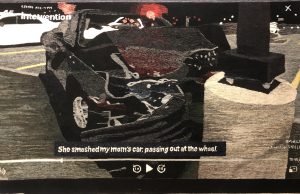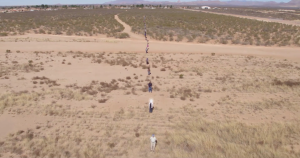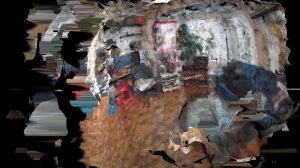with (BE)LONGING
an artwork by CANNUPA HANSKA LUGER
1.
The Covid-19 pandemic magnified and exacerbated numerous pre-existing obscenities that inhere in our society and that many of us disavow: the systemic inequalities within American society that are organized through the structure of whiteness and the legacies of colonialism. With Covid, some white people have been exposed to the helplessness, the vulnerability, death, illness, anxiety, trauma, uncertainty, and physical and mental un-safety that communities of color have routinely undergone for years. Some white people’s current abnormality is a small taste of BIPOC normality. In this sense, for the latter, there is never a normality to go back to, we are not “in this together,” as the slogan says. Working-class BIPOC lack of safety is reflected in the reality of disproportionate Covid-19 deaths in comparison to white people, and is reflected in the systematic violence of the State Apparatus. This lack of safety is pervasive, and has at last abruptly come into view for some white people—at least for the time being.
There is a violent discord between poor and working-class BIPOC and their “holding environment.” This discord is with the material environment, the institutional one, and with what Orna Guralnik calls the “discursive environment.” People need these environments to attune to them in “good enough” ways in order to feel held and safe, to thrive. Dominant ideological discourses—the ones that sustain whiteness as the hegemonic and universal perspective from which the Other is judged and measured—leave poor and working-class BIPOC unprotected, insofar as they are “designated socially unintelligible” and have to “incorporate what society wishes to turn its back on,” as Orna Guralnik says. This process leaves poor and working-class BIPOC outside the realm of life, citizenship, and subjectivity; or it projects into them whatever whiteness repudiates as excessive or abject. There is a violence that goes into these projective identifications, and that creates an inherently unsafe environment for poor and working-class BIPOC. That is why whiteness and the dominant order need to be reminded that “Black Lives Matter” and that “We Can’t Breathe.” Guralnik says that “events that threaten the taboos of social order . . . or that make large demands on people’s fragile compassion resources are easier to disavow than to ingest.” Both the Covid-19 pandemic and systemic racism are abject examples of such threatening events that test what can be grasped as human or needs to be expelled as monstrous.
2.
Allen Weiss argues that monsters are characterized by indetermination, categorical ambiguity, material incompleteness, and ontological instability. A monster is an abnormality that reminds us of a “difference in extremis” which “exist in the margins.” Poor and working-class BIPOC whom I’ve seen as patients, at one time or another, experience themselves as monsters within a social order that defines what or who is materially complete, categorically univocal, and ontologically stable.
- A second generation Mexican-American adolescent from a family who entered the United States illegally and whose Indigenous appearance made her feel ugly in a white world that bullied her. “How can English be my first language and me look like this?” she would ask me. She was Brown, had perfect English, was overweight, and eventually discovered, with me, that she was queer. She felt like a monster, so she used to cut herself and was deeply depressed.
- A Puerto Rican man who weighed more than 450 pounds and could barely walk, even with a walker. He had lived happily as a fisherman in Puerto Rico and came to the US mainland for better opportunities that never materialized. As a result, he ended up homeless and abusing drugs. He was able to get sober but became acutely depressed and started gaining weight until he could barely walk. He felt like a monster, eating all his rage.
- An Afro-Latina woman who was left by her abusive husband and became the single mother of an autistic child whom she would bring to therapy. She suffered from depression because she felt it was probably her fault that he left her, and because she could not conceive of herself as an independent woman without a man: her self-conception did not include existence without a man. Without one, she felt guilty and ugly and unwanted: a monster.
- A Brown, gay, Latino man who was applying for asylum when he first came to see me. He had been raped by his older brothers and by the police in his home country. He crossed the border and it was one of the most traumatic experiences of his life. He also suffered from discrimination in the United States on account of poverty, sexual identity, and racial identity. He had post-traumatic symptoms and suffered from medically unexplained hair loss and rashes all over his body. He also felt like a monster.
Walls and boundaries are meant to keep monsters away. A monster, coming from moneo (to warn, instruct), is an aberration that warns us of a threatening alterity that can potentially infiltrate the status quo. Monstruos bodies, in carrying “the weight of political, social, and sexual aberration or transgression,” establish the borders of the known and the acceptable.” They also create a link between the individual body and the body politic.
Remember the 2018 “Caravans of Immigrants” slowly coming to the Mexico-US border leading up to the State of the Union address and, in fantasy, menacing the union of the State? As one journalist said in an article aptly entitled “Trump’s ‘Caravan’ is a Made-up Monster Fabricated by the Far Right”:
The word “caravan” carries with it a kind of threat—of itinerant wanderers, moving as a pack, looking for land to steal for themselves. It conjures white-European fears of “Gypsies” and other invaders and is bolstered by Trump’s repeated characterizations of immigrants as criminals, rapists and gang members.
Trump then talked about a danger of “infestation,” recasting the same bio-political language as Nazi propaganda, such as the infamous documentary The Eternal Jew, put forward against the Jewish people as rats infesting the social and political body of the nation with the plague. Talk about a connection between the viral and racism: the monster-virus outside (of nation, of psyche) becomes a projection or doppelgänger of the monster-virus inside (of nation, of psyche).
Who actually stole those lands, after all? Who are the original criminals, the first rapists?
Immigrants, just like the Jewish people, function as the site of projection within this racist psychic and political economy distilled by white supremacy. Everything and everyone that is granted legal entrance into the white fortress of intelligibility and permissibility within the status quo must first be converted. This was the function of the first missionaries and the whole colonial structure, forcefully mapped onto the so-called New World.
3.
Conversion involves a converting side and a side to be converted; that is, it involves an encounter, or clash, between, to put it simply: an I vs. an Other. The relationship between the I and the Other manifests a given culture, religion, identity: a form of life. The converter is interested in changing another’s mind, heart, thought, and behavior. And there is the underlying assumption, from the viewpoint of the I, that its ideology is the true one, and that, in converting the Other, what the I is actually doing is bringing out, within the Other, such ideology that is considered to be hindered or repressed by the Other’s life-form. Conversion implies a process through which the I attempts to bring to light its own truth and desire supposed to be hidden within the Other.
This can be done forcefully (through torture, for example) but also rhetorically (through persuasion), and by the many truth technologies in between these two poles. The result is that the Other’s difference is forcefully erased and seized within the realm of the I: its own sameness, intelligibility, life, subjectivity—what Trinh T. Min-ha calls a “definite image-repertoire.” That image-repertoire seizes the threatening alterity of “the barbarian, the pagan, the infidel, the wild man, [and] the native” within a violently imposed pre-given symbolic order that delineates the intelligible and the unintelligible, the acceptable and the taboo. The Unknown is converted into the Known. This way “the Full Man, the Church, the Humanist, the Civilized Colonist and the Professional Anthropologist,” all of whom have a human face, project their needs into the ‘needy’ and position themselves as messianic saviors, revealers of the Truth within the Other. I call this conversion static and for this main reason: conversion is taken to be a process that has a specific outcome or result—the violent production of fixed and anticipated identities.
I would like to briefly introduce a form of dynamic conversion that runs in the opposite direction of the static conversion of colonialism described above. In contrast to static conversion, the idea of a dynamic conversation assigns a positive valence to the monstrous.
4.
Brazilian writer Oswald de Andrade says, regarding the symbolic function of cannibalism:
The metaphysical operation related to the cannibalistic meal is that of converting the taboo into a totem. From the opposing value to the favorable or positive value. Life is pure devouring. Within this devouring that menaces life at every moment, the task of the human is to totemize the taboo. What is the taboo but the sign of the untouchable, the limit?
The cannibalistic meal represents a critical concept, a pure devouring (cultural, historical, identitarian, etc.) that follows the flow of life’s exuberant, excessive, and tempestuous change. It is a devouring that transmutes every act of human production, every cultural encounter, and transgresses every taboo: the walled space of untouchable categories, identities, moralities, ideologies, etc. Insofar as totemizing the taboo runs counter to these limits set by entrenched power structures (what’s materially complete, categorically univocal, and ontologically stable), what I am calling dynamic conversion is a form of monstrous subversion.
Dynamic conversion is a never-ending process, mediated by the encounter between two Others, rather than an I and an Other, that is not seen from the viewpoint of identity nor of identity-making. Rather, it considers Otherness and difference to be both its starting point and its ‘result’.
Colonial narcissism makes us forget that we are also Others to those we call Others. Then, this might happen: we find that the Other is acting strangely, but they are acting strangely only in reaction to our own acting strangely as the Other that we also are. A vicious circle starts: I fear the responses produced by the Other’s fear of what I do while being afraid of them. Neither acknowledges that no one is the model of what is familiar, ordinary, non-threatening. When this happens, the Other and the one who Others, are both seized by projected and introjected fantasies that negate their primary difference.
On the side of the oppressors, think here of Amy Cooper (aka Central Park Karen), for example, who first weaponizes the trope of the dangerous Black Man and poses in front of his camera as a faux victim. After calling 911, she slowly becomes hysterically seized by what Frantz Fanon calls the “negrophobic fantasy” of the Black man as hyper-sexual and violent, as the rapist of white women, and who for this reason deserves, like Jesse Washington in 1916, among thousands of other innocent Black men, to be lynched, hung, and castrated.
In the contemporary expression of the status quo the bird-watching Black man in Central Park is not hung; instead, perhaps as a displacement, Amy Cooper is choking her dog. It is as if Amy Cooper, à la nineteenth-century hysteric exposed to the male gaze of the camera, as an extension of Charcot’s amphitheater of hysteria, was seized by the memory of a traumatic event that is ultimately a collective white fantasy. Collective negrophobic fantasies are what take possession of the bodies of Derek Chavin in murdering George Floyd, and the bodies of Travis and Gregory McMichael in lynching Ahmaud Arbery.
On the side of the oppressed, the perverse fantasies produced by whiteness seize the bodies and minds of BIPOC. Whiteness becomes a colonizing, internal object that suppresses their rage, desire, and agency. The result is internalized racism, racial melancholia, chronic depression, post-traumatic slave syndrome, extreme psychosomatic symptoms, and more. Let me provide here an example from my own experience as a psychoanalyst working many years with poor and working-class BIPOC.
The American Mental Health System has uncritically assumed that since the lives of poor and working-class BIPOC are constantly pulled by the exigencies of their basic needs, “their lives can only be defined in concrete and un-psychological terms,” as psychoanalyst Rafael Javier says. The subjectivities of poor and working-class BIPOC, framed by inherent terms of deprivation and scarcity, are often deemed inseparable from “essentialist cultural and ethnic traits” that thwart the possibility of the psychoanalytic process—understood as a meaning-making therapy that expands subjectivity. Therapy for this population too often discriminatory calls for a merely support-based, reality oriented, and symptom-focused kind of treatment. The supposed concreteness of poor and working-class BIPOC subjectivities is uncritically taken to be completely knowable and transparent in advance, hence converted into figures that belong to a definite “image-repertoire.” With this framing, poor and working-class BIPOC subjectivities are often colonially managed or “helped” or converted, with all the “good intentions,” in equally concrete ways: telling people what to do and how to lead their lives, over-medicalization, over-hospitalization, or assuming that what is needed are “coping techniques,” which include breathing techniques, the neoliberal ideology of wellness, or positive thinking and its tyranny of happiness. This reductive approach cruelly teaches how to merely cope with misery, oppression, discrimination, and marginality, not to transform it.
How are mental health professionals going to, with a clear conscience, continue to solely teach breathing exercises to poor and working-class BIPOC patients after a social movement organized around the cry “I can’t breathe” is underway? Wouldn’t this be cruel, or a form of victim blaming, insofar as it ignores the systematic at the heart of the symptomatic?
Something like:
Patient: “I can’t breathe.”
Therapist: ‘Well, breathe better.”
In this way, the Euro-American, class-based conceptions of the American Mental Health System effectively erase the subjectivity of poor and working-class BIPOC. It functions as an apparatus, in the Foucaultian sense of the term, that is constituted by a set of hegemonic ideologies about mental health and subjectivity. These work in tandem with specific practices that are at once legal, political, and clinical, and that administrate mechanisms which exercise power and violence over the bodies of BIPOC. The American Mental Health System is an apparatus where poor and working-class BIPOC are pathologized or made concrete through assumptions which suppress any notion of agency. Individuals and communities are, rather, victimized as powerless, dependent, infantile, or underdeveloped individuals, capable of little self-reflection or self-determination. Though it is true that all working classes and poor people in the United States are considered inferior due to their being socio-economically disadvantaged, in the case of BIPOC and other minorities the discrimination is intersected with ethnic and racial prejudices that are interwoven with class conditions. The symptoms and sufferings of these populations, which, for psychoanalysis, carry a secret protest against the logic of discriminatory and oppressive realities, and which have been internalized, are converted and silenced within “manageable care,” pre-given outcomes, and standardized forms of treatment that prescribe what it means to be “healthy” and “normal.”
My experience has shown me how, within the American Mental Health System, there is a persistent divide between its biased assumptions about the subjectivity of poor and working-class BIPOC and how these subjects make the clinic in creative ways that force clinicians to reformulate praxis when working in the US. Unless clinicians, of course, want to repeat, now at the level of the treatment, the same kind of oppressions, projections, discriminations, and conversions, that poor and working-class BIPOC individuals and communities have endured all their lives. This is what I have in mind in speaking about a dynamic conversion: a primary positivity, the action of devouring symbolized by the cannibalistic meal, as a form of going beyond any apparatus or structure that attempts to bound or limit life’s essential alterity. As a continuous, differentiating process, the cannibalistic scene is the symbol of a subversive unconscious that is monstrous in that it works against the boundaries of the ego and the super-ego (allied to the status quo and to tradition: “cadaveric institutionality,” as De Andrade calls it). It is this subversive unconscious which, as I said before, carries a yet-to-be-told protest against that which oppresses poor and working-class BIPOC. This was already the case in nineteenth-century hysterical women whose symptoms, considered monstrous, can in fact be seen as forms of subversion against patriarchy. Under this model, the monstrous is liberatory.
5.
I have been talking with Oswald de Andrade about converting the taboo into a totem: the exaltation of the devoured Other. The ritual aspect of cannibalism is eating the “sacred enemy” who functions as the symbol of a radical alterity that is nonetheless venerated, and, due to this, incorporated within your very being. As Freud says in Totem and Taboo, for totemic cultures “the totem embodies the community, which is the real genuine object of veneration.” Totemizing the taboo has to do with the question of how to organize a community around the totemic incorporation of the radically Other, an alterity that becomes the genuine organizing principle of the community and its true object of immanent veneration.
I find this quite provocative: a community whose sense, organizing principle, and source of veneration comes, as Freud says, from a process of “naming from without.” It is a community that is constitutively named and immanently built around Otherness and difference: around what it is not. As such, it always lacks any stable, autochthonous, and identitarian foundation, standard, or “origin.” It does not start—as with the static conversion of colonialism—from the I, but rather from Otherness-as-originary. Otherness becomes the immanent yet transcendent (un)foundation of the community. What threatens a social order based on this structure is, in opposition to the colonial fortress of intelligibility and permissibility, the taboo itself.
Within the sphere of thought, this clears up the ground for a discipline or method without autonomous discipline or method. A thinking that is incessantly (un)founded by difference or Otherness forces us to think the difficult thought of a case that, in a sense, always inaugurates a new category that therefore is, paradoxically, an example of itself: absolute singularity. It is what I would call a science of singularity, a notion very much against the Western metaphysical tradition which Oswald De Andrade calls “Messianic Philosophy,” not without having in mind the messianic drive of the colonizers.
I wonder if the American Mental Health System, and also North-American psychoanalysis, are up for the task of freeing themselves from the white colonial fortress that sequestered them. If psychoanalysis could be that science of singularity that lets its practices, mode of thinking, and institutionality be unsettled by the imprint of what I called the subversive unconscious of radical alterity. If it can tolerate a seizure of this nature and still recognize itself. If, in so doing, it will be able to tear down its own walls and let itself be seized by the caravan of voices of those “monsters” that have been left outside, or by the silenced voices of those who can’t breathe inside the hegemonic structures and discourses of the fortress of whiteness. At its best, which means the truest to its progressive origins represented by Freud’s free clinics, the psychoanalytic process offers the silenced Other a space where they can freely speak their minds without any predetermined agenda or “treatment plan.” It does not function according to what Jacques Alain Miller calls a “principle of utility.” It rather operates indirectly through an interweaving of contingency and overdetermination (excess) that constitutes a site of contestation of the ways in which the erased Other’s subjectivity is foreclosed and therefore depleted of agency and depth.
Allen, Ian. “Trumps ‘Caravan’ is a Made-up Monster Fabricated by the Far Right.” The Nation, 19 Feb. 2019, https://www.thenation.com/article/archive/caravan-white-supremacist-campaign-trump/.
Bernstein, Patricia. The First Waco Horror: The Lynching of Jesse Washington and the Rise of the NAACP, Texas A&M UP, 2005.
De Andrade, Oswald. Manifesto antropófago e outros textos. Rio de Janeiro: Penguin-Companhia Das Letras, 2017.
De Andrade, Oswald. “A Crise da Filosofia Messiânica.” Do Pau-Brasil à Antropofagia e às Utopias: manifestos, teses de concursos e ensaios, Rio de Janeiro: Civilização brasileira, 1978.
Fanon, Frantz. Black Skins, White Masks. Grove Press, 1967.
Freud, Sigmund. “Totem and Taboo.” The Standard Edition of the Complete Psychological Works of Sigmund Freud, Volume XIII (1913-1914): Totem and Taboo and Other Works, edited and translated by James Strachey, Hogarth Press, 1953-1974, pp. vii-162.
Guralnik, Orna. “Depersonalization: Standing in the Space between Recognition and Interpellation.” Psychoanalytic Dialogues, vol. 20, no. 4, 2010, pp. 400-16.
Javier, Rafael. “The Suitability of Insight-Oriented Therapy for the Hispanic Poor.” The American Journal of Psychoanalysis, vol. 50, no. 4, 1990, pp. 305-18.
Minh-ha, Trinh. “The Language of Nativism: Anthropology as a Scientific Conversation of Man with Ma.” Women Native Other, U of Indiana Press, 1986.
Weiss, Allen S. Ten Theses on Monsters and Monstrosity. The Drama Review, vol. 18, 2004, pp. 124-5.
(BE)LONGING (2019)
“I live because my ancestors survived a war of attrition. Carried out by settlers in order to subjugate Plains Tribes, this war of attrition decimated the North American buffalo population. By the year 1895, buffalo herds declined from tens of millions to a mere 1500. Historic images of this era documented massive pyramids of buffalo skulls as monuments of conquest scattered throughout my ancestral lands of the Great Plains. This loss of species not only affected my ancestors but also the land. Running down the center of North America, the Great Plains are one of the most endangered environments; many Indigenous grasses are dependent on the buffalo to thrive and have therefore also degenerated. In fact, there can be no true restoration without roaming herds of buffalo. (Be)longing explores the cascading effects of a decimated species on our precious and interconnected environment.
(Be)Longing is a figurative ceramic and steel sculpture in the form of a full-sized buffalo skeleton that is both sculpture and subject in a series of videos. Shot by drone, this video surveys a river, encountering the buffalo skeleton submerged in the shallow headwaters where it ostensibly taints the water source. The installation includes both the massive skeleton and this video.
(Be)Longing expresses how losing one species a hundred years ago has lasting effects in the 21st century. Through installation, sculpture, and video, the piece implores audiences not to wait another hundred years to protect the next species in peril.”
~ Cannupa Hanska Luger

CARLOS PADRÓN writer
Carlos Padrón is a psychoanalyst with a background in philosophy working in NYC. He is currently a faculty member at the Institute for Psychoanalytic Training and Research and at the Silberman School of Social Work (MSW). Carlos participated in the documentary Psychoanalysis in El Barrio, a film on working psychoanalytically with underprivileged Latinx patients in the US. He published essays in the volume Psychoanalysis in the Barrios (Routledge, 2019) and in a special edition of Division Review (2020) dedicated to Covid-19 and racism. Carlos has worked psychoanalytically in different settings, and is currently a clinical associate of the New School Psychotherapy Program.
CANNUPA HANSKA LUGER artist
Cannupa Hanska Luger is a multi-disciplinary artist of Mandan, Hidatsa, Arikara, Lakota descent. Using social collaboration and in response to timely and site-specific issues, Luger produces multi-pronged projects provoking diverse publics to engage with Indigenous peoples and values apart from the lens of colonial social structuring. He exhibits, lectures and participates in projects globally.
(BE)LONGING (2019): mixed media: life-size buffalo skeleton, sculptural installation (ceramic, steel, ribbon, fiber, video).
(Be)Longing is in the permanent collection of The Hood Museum of Art at Dartmouth College, Hanover, New Hampshire, in the United States.
© Copyright for all texts published in Stillpoint Magazine are held by the authors thereof, and for all visual artworks by the visual artists thereof, effective from the year of publication. Stillpoint Magazine holds copyright to all additional images, branding, design and supplementary texts across stillpointmag.org as well as in additional social media profiles, digital platforms and print materials. All rights reserved.




